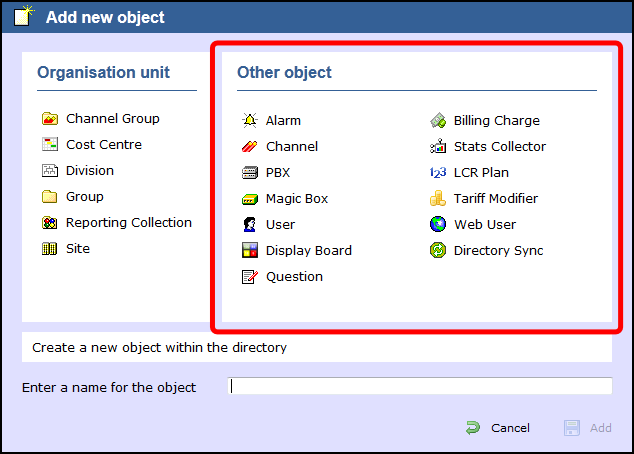The Other objects section comprises a list of different objects, each representing an additional feature you can add to the call logger, such as integrating call recording, set up system alarms, add a billing charge, perform directory sync, etc.
The Other objects section comprises a list of different objects that can be added to the Directory in order to perform a specific function, such as integrating call recording, display boards, set up system alarms, perform directory sync, etc.
The objects can be placed at any hierarchical level, allowing maximum flexibility when creating the Directory.

The objects available are presented in the table below:
| Object | Description |
|---|---|
Alarm | An Alarm object can be set up at any level of the Directory in order to trigger an alert when calls whose properties match certain criteria have happened, such as calls above a particular duration, calls to specific phone numbers, or when user-defined cost thresholds are exceeded. The criteria that must be met to trigger an alarm is user-defined, and email alerts can be sent to one or more recipients. |
| Channel | Channels are system objects representing your telephone lines. When you first configure the system, your channels are automatically harvested from the data received from the phone system. The properties of each channel can be edited afterwards, and channels can also be organised subsequently into new groups, if preferred. |
PBX | The function of a PBX object is to acquire call logging data from a telephone system. TIM Enterprise can be configured to take call records from a single PBX covering multiple sites or you can connect to a number of PBXs. |
| Magic Box | If you want to record the telephone conversation and have it attached as another property of each call, you simply need to upgrade and add a Magic Box to whatever group of lines you would like to record. A link to the actual call recording will then appear alongside each recorded call on TIM Enterprise. |
| User | Users will automatically be picked up by TIM Enterprise when a call is made. You may pre-configure and add Users at any time. |
| Display Board | Display boards are completely customisable web pages that can be displayed on any large screen, or viewed as a web page on a PC or via a portable device e.g. iphone, PDA, Blackberry. Display boards can be made up of any combination of Label panels, Leader boards, Summary panels, RSS feeds and Web pages. |
| Question | Questions can be added to the directory of TIM Enterprise to allow users to score calls. The results of the call scoring report will vary depending on the type of questions used to create your scorecards. The questions can have three types of answer; Yes/No answers, range answers and multiple choice answers. |
| Billing Charge | Billing charges allow to add additional billing charges or markups to calls, users or bills. Billing charges can be applied as a % or fixed charge. When several charges are added to one bill, the charges can be prioritised in order of importance. |
| Stats Collector | A stats collector is a 'counter' that can be based on any subject and be placed at any point in your Directory's hierarchy. It counts calls that match defined parameters as they pass. The information from these stats points can then be selected and displayed on your customisable Display boards. |
| LCR Plan | LCR Plans can be applied anywhere in the Directory to allow you to mimic your actual call routing plans for costing purposes. |
| Tariff Modifier | Tariff Modifiers can be applied anywhere in your Directory. This allows you to apply different tariffs throughout the Directory. |
| Web User | TIM Enterprise allows you to allow an unlimited number of users to interrogate the system via the web. These users are called Web Users. Web Users can be allowed access to the entire system or restricted to any specific area of your Directory. |
| Directory Sync | The Directory sync object in TIM Enterprise allows you to sync any partition of TIM Enterprise with a 3rd party directory e.g. Active Directory, Cisco AXL etc. |